1. Tsukada H, Satou T, Iwashima A, Souma T. Diagnostic accuracy of CT-guided automated needle biopsy of lung nodules. AJR Am J Roentgenol. 2000; 175:239–243. PMID:
10882279.

2. Takeshita J, Masago K, Kato R, Hata A, Kaji R, Fujita S, et al. CT-guided fine-needle aspiration and core needle biopsies of pulmonary lesions: a single-center experience with 750 biopsies in Japan. AJR Am J Roentgenol. 2015; 204:29–34. PMID:
25539234.

3. Poulou LS, Tsagouli P, Ziakas PD, Politi D, Trigidou R, Thanos L. Computed tomography-guided needle aspiration and biopsy of pulmonary lesions: a single-center experience in 1000 patients. Acta Radiol. 2013; 54:640–645. PMID:
23528565.

4. Manhire A, Charig M, Clelland C, Gleeson F, Miller R, Moss H, et al. BTS. Guidelines for radiologically guided lung biopsy. Thorax. 2003; 58:920–936. PMID:
14586042.

5. Laurent F, Montaudon M, Latrabe V, Bégueret H. Percutaneous biopsy in lung cancer. Eur J Radiol. 2003; 45:60–68. PMID:
12499065.

6. Birchard KR. Transthoracic needle biopsy. Semin Intervent Radiol. 2011; 28:87–97. PMID:
22379279.

7. Yoon SH, Park CM, Lee KH, Lim KY, Suh YJ, Im DJ, et al. Analysis of complications of percutaneous transthoracic needle biopsy using CT-guidance modalities in a multicenter cohort of 10568 biopsies. Korean J Radiol. 2019; 20:323–331. PMID:
30672172.

8. Schreiber G, McCrory DC. Performance characteristics of different modalities for diagnosis of suspected lung cancer: summary of published evidence. Chest. 2003; 123(1 Suppl):115S–128S. PMID:
12527571.
9. Gelbman BD, Cham MD, Kim W, Libby DM, Smith JP, Port JL, et al. Radiographic and clinical characterization of false negative results from CT-guided needle biopsies of lung nodules. J Thorac Oncol. 2012; 7:815–820. PMID:
22729035.

10. Fontaine-Delaruelle C, Souquet PJ, Gamondes D, Pradat E, De Leusse A, Ferretti GR, et al. Negative predictive value of transthoracic core-needle biopsy: a multicenter study. Chest. 2015; 148:472–480. PMID:
25569025.
11. Lee KH, Lim KY, Suh YJ, Hur J, Han DH, Kang MJ, et al. Nondiagnostic percutaneous transthoracic needle biopsy of lung lesions: a multicenter study of malignancy risk. Radiology. 2019; 290:814–823. PMID:
30561276.
12. Wu CC, Maher MM, Shepard JA. CT-guided percutaneous needle biopsy of the chest: preprocedural evaluation and technique. AJR Am J Roentgenol. 2011; 196:W511–W514. PMID:
21512038.

13. O'Neill AC, McCarthy C, Ridge CA, Mitchell P, Hanrahan E, Butler M, et al. Rapid needle-out patient-rollover time after percutaneous CT-guided transthoracic biopsy of lung nodules: effect on pneumothorax rate. Radiology. 2012; 262:314–319. PMID:
22106349.
14. Gupta S, Wallace MJ, Cardella JF, Kundu S, Miller DL, Rose SC. Society of Interventional Radiology Standards of Practice Committee. Quality improvement guidelines for percutaneous needle biopsy. J Vasc Interv Radiol. 2010; 21:969–975. PMID:
20304676.

15. Quint LE, Kretschmer M, Chang A, Nan B. CT-guided thoracic core biopsies: value of a negative result. Cancer Imaging. 2006; 6:163–167. PMID:
17098648.

16. Priola AM, Priola SM, Cataldi A, Errico L, Di Franco M, Campisi P, et al. Accuracy of CT-guided transthoracic needle biopsy of lung lesions: factors affecting diagnostic yield. Radiol Med. 2007; 112:1142–1159. PMID:
18074198.

17. Minot DM, Gilman EA, Aubry MC, Voss JS, Van Epps SG, Tuve DJ, et al. An investigation into false-negative transthoracic fine needle aspiration and core biopsy specimens. Diagn Cytopathol. 2014; 42:1063–1068. PMID:
24866385.

18. Anderson JM, Murchison J, Patel D. CT-guided lung biopsy: factors influencing diagnostic yield and complication rate. Clin Radiol. 2003; 58:791–797. PMID:
14521889.

19. Calhoun P, Feldman PS, Armstrong P, Black WC, Pope TL, Minor GR, et al. The clinical outcome of needle aspirations of the lung when cancer is not diagnosed. Ann Thorac Surg. 1986; 41:592–596. PMID:
3718033.

20. Savage C, Walser EM, Schnadig V, Woodside KJ, Ustuner E, Zwischenberger JB. Transthoracic image-guided biopsy of lung nodules: when is benign really benign? J Vasc Interv Radiol. 2004; 15(2 Pt 1):161–164. PMID:
14963182.

21. Wang Y, Li W, He X, Li G, Xu L. Computed tomography-guided core needle biopsy of lung lesions: diagnostic yield and correlation between factors and complications. Oncol Lett. 2014; 7:288–294. PMID:
24348866.

22. Greif J, Marmor S, Schwarz Y, Staroselsky AN. Percutaneous core needle biopsy vs. fine needle aspiration in diagnosing benign lung lesions. Acta Cytol. 1999; 43:756–760. PMID:
10518126.

23. Klein JS, Salomon G, Stewart EA. Transthoracic needle biopsy with a coaxially placed 20-gauge automated cutting needle: results in 122 patients. Radiology. 1996; 198:715–720. PMID:
8628859.

24. Yeow KM, Su IH, Pan KT, Tsay PK, Lui KW, Cheung YC, et al. Risk factors of pneumothorax and bleeding: multivariate analysis of 660 CT-guided coaxial cutting needle lung biopsies. Chest. 2004; 126:748–754. PMID:
15364752.
25. Montaudon M, Latrabe V, Pariente A, Corneloup O, Begueret H, Laurent F. Factors influencing accuracy of CT-guided percutaneous biopsies of pulmonary lesions. Eur Radiol. 2004; 14:1234–1240. PMID:
14963689.

26. Petranovic M, Gilman MD, Muniappan A, Hasserjian RP, Digumarthy SR, Muse VV, et al. Diagnostic yield of CT-guided percutaneous transthoracic needle biopsy for diagnosis of anterior mediastinal masses. AJR Am J Roentgenol. 2015; 205:774–779. PMID:
26397325.

27. Klein JS, Zarka MA. Transthoracic needle biopsy: an overview. J Thorac Imaging. 1997; 12:232–249. PMID:
9368219.
28. Topal U, Ediz B. Transthoracic needle biopsy: factors effecting risk of pneumothorax. Eur J Radiol. 2003; 48:263–267. PMID:
14652144.

29. Choi SH, Chae EJ, Kim JE, Kim EY, Oh SY, Hwang HJ, et al. Percutaneous CT-guided aspiration and core biopsy of pulmonary nodules smaller than 1 cm: analysis of outcomes of 305 procedures from a tertiary referral center. AJR Am J Roentgenol. 2013; 201:964–970. PMID:
24147465.

30. Yao X, Gomes MM, Tsao MS, Allen CJ, Geddie W, Sekhon H. Fine-needle aspiration biopsy versus core-needle biopsy in diagnosing lung cancer: a systematic review. Curr Oncol. 2012; 19:e16–e27. PMID:
22328844.
31. Lucidarme O, Howarth N, Finet JF, Grenier PA. Intrapulmonary lesions: percutaneous automated biopsy with a detachable, 18-gauge, coaxial cutting needle. Radiology. 1998; 207:759–765. PMID:
9609901.


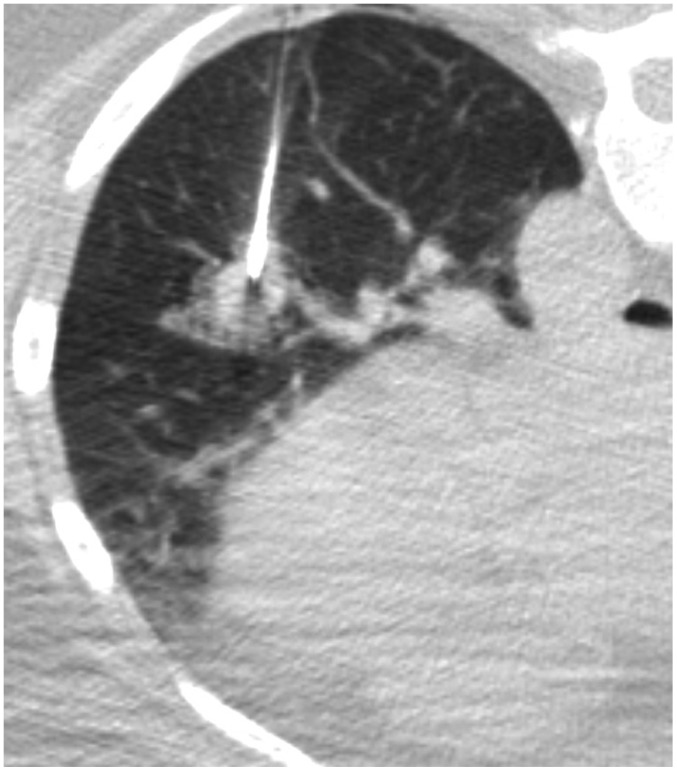
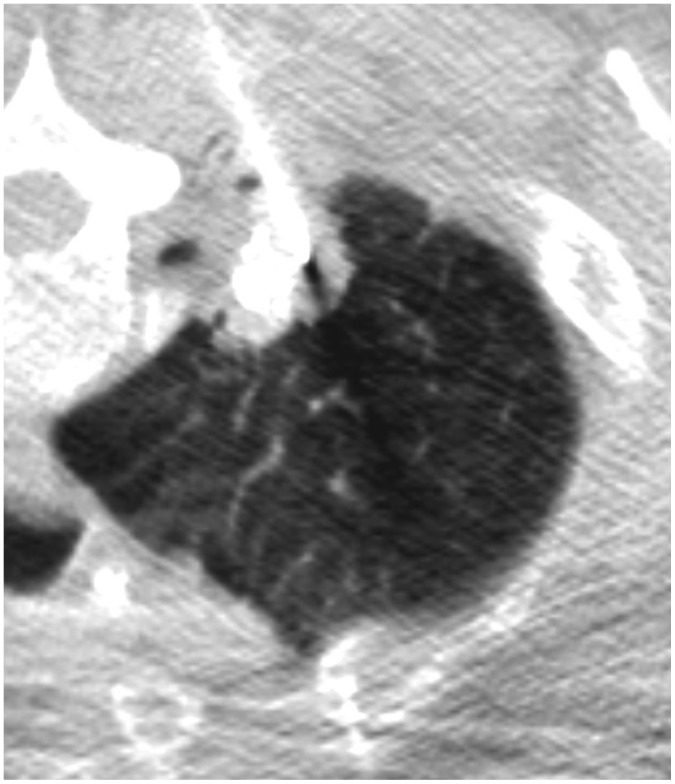
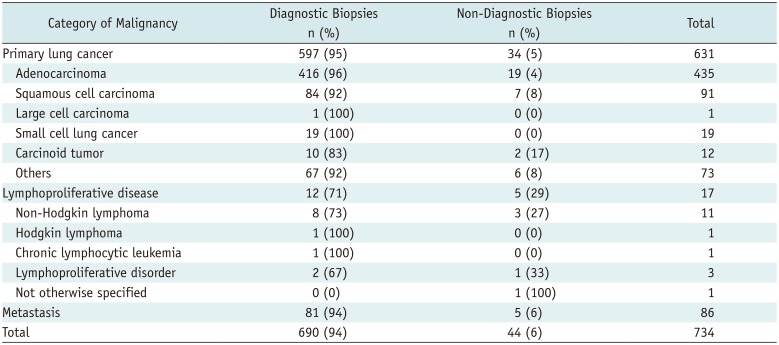

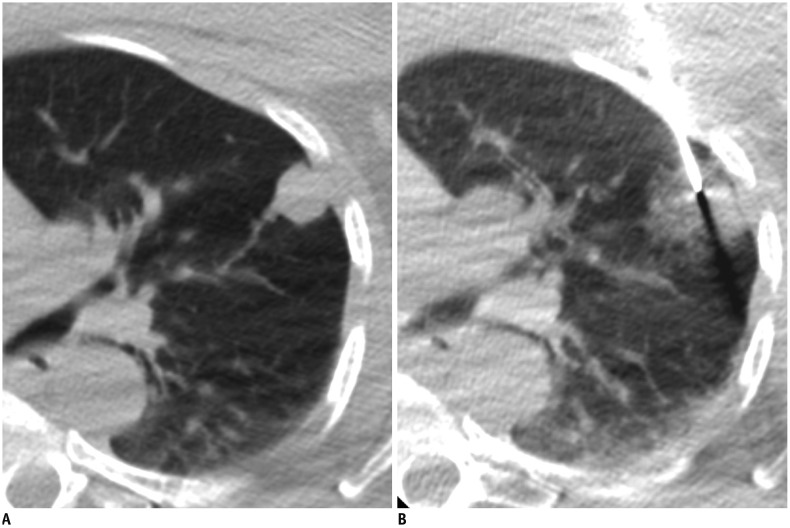
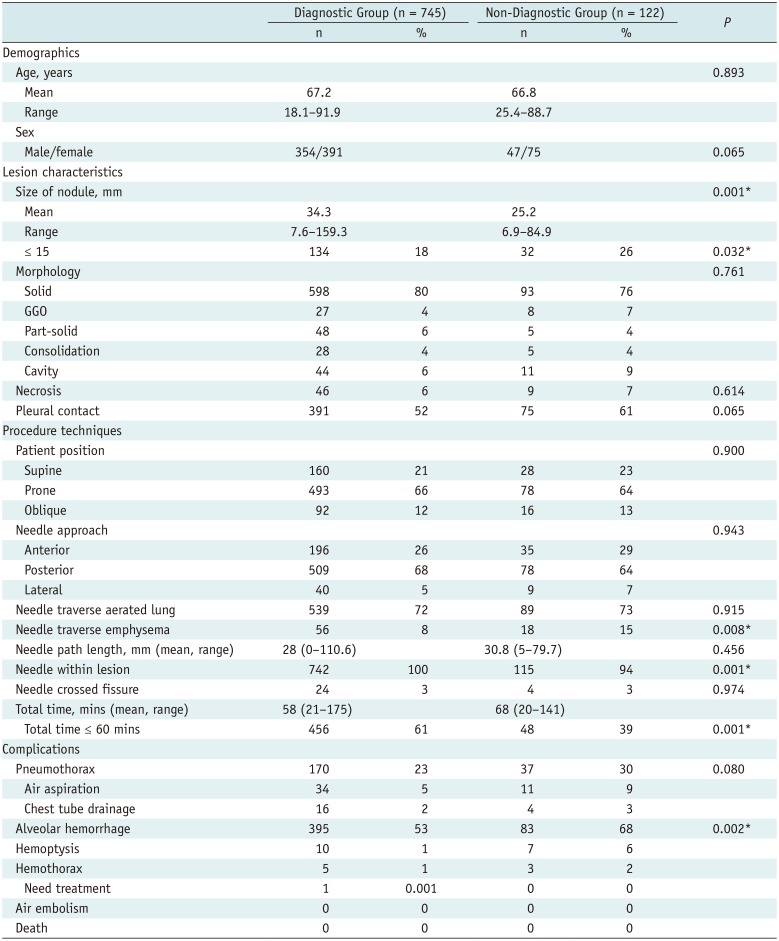
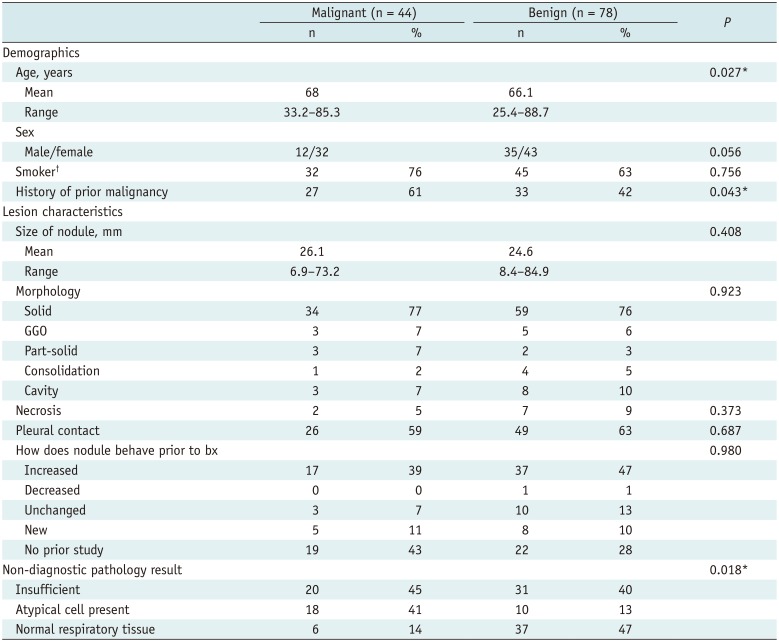





 PDF
PDF ePub
ePub Citation
Citation Print
Print



 XML Download
XML Download